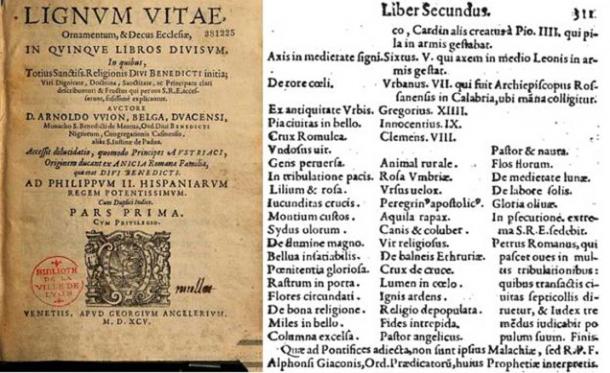In 1595, a Benedictine monk named Arnold de Wyon published Lignum Vitae – in which he claimed to have “discovered The Prophecy of the Popes,” which were originally written by St. Malachy, the Archbishop of Armagh in 1143. In 1871, Abbé Cucherat, in his book The Prophecies of the Succession of the Popes , tells us that in 1139 Malachy was “summoned to Rome Pope Innocent II to receive two wool palliums for the metropolitan sees of Armagh and Cashel.”
While in Rome, Malachy is said to have experienced a “vision of future popes,” which he recorded as a sequence of cryptic phrases describing their personality traits. St. Malachy allegedly gave his manuscript to Innocent II and the document remained unknown in the Roman Archives until its discovery in 1590.

Examining the Papal Prophecy
The first pope listed after St. Peter was Ex caſtro Tiberis, who is noted as having lived in a “castle on the Tiber.” Regarding the final Pope, de Wyon claimed that Malachy wrote an apocalyptic statement which translates from Latin as:
“In the extreme persecution of the Holy Roman Church, there will sit. [sic] Peter the Roman, who will nourish the sheep in many tribulations; when they are finished, the city of seven hills will be destroyed, and the dreadful judge will judge his people. The end.”
When the text was discovered in 1595 it caused great intrigue and carried an air of legitimacy because so many of Malachy’s descriptions matched those of previous Popes. To many, the resignation of Benedict XVI in 2013 or the day he died 31/12/2022 indicated the beginning of the End of Days – also as prophesied.
However, not a shred of tangible evidence exists to associate Malachy with the prophecy, and the “original document” that de Wyon claimed to have “found” in the Vatican Secret Archives has never been seen by anyone else, ever. Soon after its discovery, many Catholic scholars deemed it as a contemporary forgery, however many others have continued to believe in the document’s authenticity.
Skeptics argue that historically when people had prophetic visions they told a lot of people, but Malachy apparently didn’t mention his vision to a soul, nor did his biographer, St. Bernard of Clairvaux; who documented several of Malachy’s other alleged miracles. And, depending on how you interpret the prophecy, Benedict XVI is not the 111th pope! Ten antipopes are listed among the “112 Popes” – so it is argued that Benedict XVI was the 101st pope.
The Papal Prophecy – Real or Forgery?
Among the historians who maintained that the prophecies were a late 16th‑century forgery, Spanish monk and scholar Benito Jerónimo Feijóo y Montenegro wrote Teatro Crítico Universal between 1724–1739. In an entry entitled ‘Purported prophecies’ he observed a “high level of accuracy in the descriptions of the popes until the date they were published” … then, a “high level of inaccuracy after the publication date.” Friar Benito Jerónimo Feijóo y Montenegro was a Spanish monk and scholar who led the Age of Enlightenment in Spain and debunked myths and superstitions. This observation convinced him the prophecy was “created just before its publication.”
Having established that the prophecy was most probably a hoax, why were the prophecies created in the first place? A theory was forward by a 17th-century French priest Louis Moréri in his encyclopedia Le Grand Dictionnaire historique which suggested “supporters of Cardinal Girolamo Simoncelli created them in a bid to support his bid to become pope in the 1590s.” His evidence was in that the prophecies predicted the pope that would follow Urban VII was “Ex antiquitate Urbis” (“from the old city”), and Simoncelli was from Orvieto, which in Latin is Urbevetanum “old city” (Miller, 1981).
Writing extensively about the prophecy being a forgery, M. J. O’Brien, a Catholic priest who authored an 1880 monograph on the prophecies said: “These prophecies have served no purpose. They are absolutely meaningless. The Latin is bad. It is impossible to attribute such absurd triflings … to any holy source. Those who have written in defence of the prophecy have brought forward scarcely an argument in their favour. Their attempts at explaining the prophecies after 1590 are, I say with all respect, the sorriest trifling” (O’Brien, 1880).
What Does the Popes Prophecy Say of Today and Tomorrow?
If the list of descriptions is matched directly to a list of historic popes since its publication, Benedict XVI (2005–13) corresponds to the second last noted pope, described as “Gloria olivae” (the glory of the olive).
And the final prophecy predicts the Apocalypse: “In the final persecution of the Holy Roman Church, there will sit Peter the Roman [as bishop], who will pasture his sheep in many tribulations (COVID-19, War in Ukraine, coming war between Israel and Iran) and when these things are finished, the city of seven hills [i.e. Rome] will be destroyed, and the dreadful judge will judge his people. The End.”
Check out —> Prophecy of the Popes- The Last Popes.
Source: Ancient Origins
